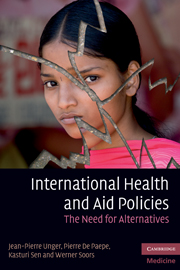Book contents
- Frontmatter
- Contents
- Preface
- Biographies
- Notices
- Acknowledgements
- List of abbreviations
- Reviews
- Introduction: Overview and purpose
- Section 1 Paradigms of international policies
- Section 2 The failure of the aid paradigm: poor disease control in developing countries
- Section 3 Impact of international health policies on access to health in middle-income countries: some experiences from Latin America
- Section 4 Determinants and implications of new liberal health policies: the case of India, China and Lebanon
- Section 5 Principles for alternative, publicly oriented health care policies, planning, management and delivery
- Section 6 A public health, strategic toolkit to implement these alternatives
- 17 Person-centred care: a key to strengthening health care and systems in low- and middle-income countries?
- 18 Improving access
- 19 Improving clinical decision making
- 20 Reorienting academic missions: how can public health departments and public health teaching in particular best support access to good quality comprehensive health care?
- Conclusions
- Glossary
- Index
- References
18 - Improving access
Published online by Cambridge University Press: 06 December 2010
- Frontmatter
- Contents
- Preface
- Biographies
- Notices
- Acknowledgements
- List of abbreviations
- Reviews
- Introduction: Overview and purpose
- Section 1 Paradigms of international policies
- Section 2 The failure of the aid paradigm: poor disease control in developing countries
- Section 3 Impact of international health policies on access to health in middle-income countries: some experiences from Latin America
- Section 4 Determinants and implications of new liberal health policies: the case of India, China and Lebanon
- Section 5 Principles for alternative, publicly oriented health care policies, planning, management and delivery
- Section 6 A public health, strategic toolkit to implement these alternatives
- 17 Person-centred care: a key to strengthening health care and systems in low- and middle-income countries?
- 18 Improving access
- 19 Improving clinical decision making
- 20 Reorienting academic missions: how can public health departments and public health teaching in particular best support access to good quality comprehensive health care?
- Conclusions
- Glossary
- Index
- References
Summary
Part 1: Access to curative care in first-line health services: an experience in Ecuador
Introduction
In LMICs it is generally acknowledged that access to curative care could be improved if primary care health services were strengthened and new health centres opened when required, if in addition skilled teams are organized in these services and if resource allocation does not discriminate against primary care as has historically been the case in many LMICs. Some publications also focus on the importance of good doctor-patient communication, as highlighted in Chapter 17 of this section, to improve access and to ensure effective integration of health services (Haddad & Fournier, Litvack & Bodart, 1993). There are also important technical dimensions of supporting primary care health services, including sustainable drug supplies in public services (Hanson & Gilson, 1993) (see Part 2 of this chapter).
However, while many publications analyze the determinants of service utilization and the impact of services on health status, little has been published on how to actually improve access to health care because the discussion to date has been part of a larger neoliberal policy framework, that views comprehensive care as rhetoric as well as in isolation from publicly oriented health services.
The following Part 1 describes a study based on empirical research and interventions in several sites which was implemented by an international team to improve access to curative health care in a network of MoH health centres (primary care health services) in Ecuador between 1993 and 1998.
- Type
- Chapter
- Information
- International Health and Aid PoliciesThe Need for Alternatives, pp. 210 - 224Publisher: Cambridge University PressPrint publication year: 2010
References
- 1
- Cited by



